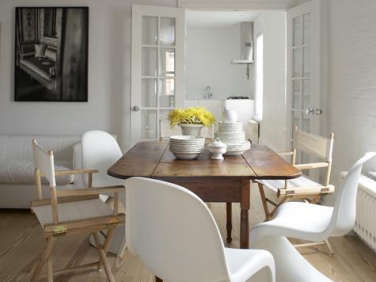When her San Francisco interior design firm tripled in size in as many years, founder Nicole Hollis embarked on a year-long search for a new space. When she found it—a 5,000-square-foot former industrial building in the rapidly growing SOMA neighborhood of San Francisco—it was a tech office “with small rooms and bad carpet.” What she wanted instead was “a creative laboratory—a white canvas where the staff have all the tools they need but can also be inspired and encouraged to collaborate,” she says.
Hollis, whose firm is a member of the Remodelista Architect/Designer Directory, saw past the gloomy interiors and capitalized on the building’s former, loft-life glory. She tore down walls and poured new concrete floors, and the result is signature Hollis: high-design nods, a graphic black and white palette, plus a dash of noirish glamour.
Photography by Laure Joliet, courtesy of Nicole Hollis.

Above: The reception desk, a brass-clad box by Oakland’s Chris French Metal, is Hollis’s “ode to Donald Judd.”

Above: Though it serves as headquarters for the firm’s roughly 40 employees, the studio “is also for clients to see how we work,” Hollis says.

Above: Interior walls are blackened with shou sugi ban, a Japanese wood-charring technique.
Above: Near the front desk, a dramatic entry salon has ebony walls that are integrally colored Italian plaster and a fireplace façade with a custom metal insert. A Bec Brittain chandelier hangs above a painting by German artist Udo Nöger and a Hepburn Sofa by Matthew Hilton for De la Espada from the Future Perfect.

Above: FontanaArte Avico pendants hang over custom computer stations by Oakland’s Mueller Nicholls—the desks can be raised and lowered for standing or sitting. Hollis kept the building’s original steel windows and had the board-formed concrete ceiling painted white.
Above: Nicole shares her office with Lewis Heathcote, her husband and the firm’s CEO. Heathcote sits facing the studio, while Hollis faces the city views spanning the San Francisco Bay Bridge to Twin Peaks.
Above: A Verner Panton for Vitra Dining Chair serves as Hollis’s office chair. A Vico Magistretti Atollo sits on the credenza in the background. On the walls Hollis used Benjamin Moore Decorator’s White throughout.

Above: The materials library: “Vendors, artists, architects, and other designers drop off samples and artwork for us daily,” Hollis says. “It’s a rotating salon.”
Above: Materials boards, sorted by project.

Above: The studio kitchen’s black backsplash is made of hand-glazed Moroccan Clé tile, with a “bleached metal” surround—an experimental technique done in collaboration with Chris French Metal.
Above: The kitchen island, with custom steel base and Calacatta marble top by CoorItalia, was “designed to invite socializing,” Hollis says.

Above: The communal dining table is meant to encourage social interaction and family-style lunches. The table is a James Perse design.
For more from Nicole Hollis, see:
- A Serene Sonoma Guest Retreat
- Paint Colors with Cult Followings: 10 Picks from the Remodelista Architect & Designer Directory
- 10 Architects’ Tricks for Creating a European-Inspired Interior












Have a Question or Comment About This Post?
Join the conversation (4)